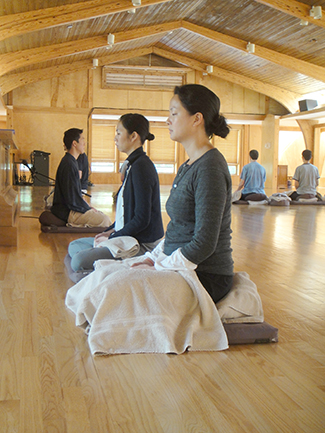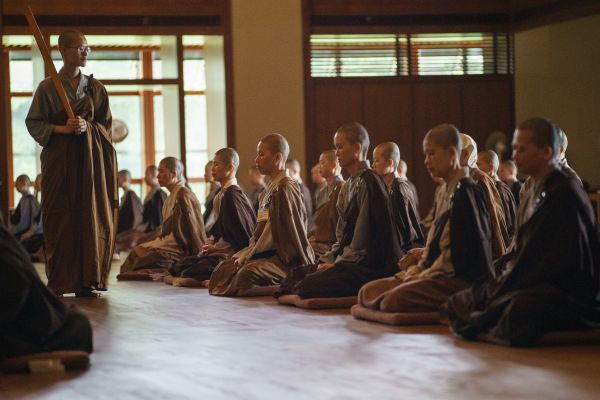Global Buddhist Community
The Chan Practice of Non-abiding (II)
This is the second part of The Chan Practice of Non-abiding written by Ven. Guo Xing, a Dharma heir of the late Master Sheng Yen. Ven. Guo Xing is the Managing Director of DDM's Chan Hall and the former abbot of the Dharma Drum Retreat Center, New York, as well of the Chan Meditation Center in Queens, New York. The article was translated from Chinese by Echo Bonner and Harry Miller, and edited by Ernest Heau. (Check out the first part here.)
 The purpose of the first stage, relaxing body and mind, and the second stage, experiencing the breath, is to calm and stabilize the mind. These are the foundations for the third stage, contemplating the total body. It is only at this third stage that the practice of nonabiding really begins. When you know how to contemplate the total body, you can use this principle and go to the fourth stage, contemplating the environment as a whole, and then the fifth stage, direct contemplation and the sixth stage, contemplating emptiness. When one reaches the point where all bodily sensations disappear, or there is neither body part, nor sensation, nor breath, nor thought to be contemplated, contemplating the environment begins. The fifth and sixth stages are entered naturally.
The purpose of the first stage, relaxing body and mind, and the second stage, experiencing the breath, is to calm and stabilize the mind. These are the foundations for the third stage, contemplating the total body. It is only at this third stage that the practice of nonabiding really begins. When you know how to contemplate the total body, you can use this principle and go to the fourth stage, contemplating the environment as a whole, and then the fifth stage, direct contemplation and the sixth stage, contemplating emptiness. When one reaches the point where all bodily sensations disappear, or there is neither body part, nor sensation, nor breath, nor thought to be contemplated, contemplating the environment begins. The fifth and sixth stages are entered naturally.
Contemplating the total body means that you clearly and vividly perceive the total body, not reacting to any particular phenomena, and you are not occupied by a particular part of the total body. The total body, as we have said, includes everything associated with it—breathing and a wide variety of sensations and thoughts. Because you do not react to any phenomenon, illusory thoughts gradually arise less and less. The mind gradually becomes unmoving. The illumination (vipassana) aspect of Silent Illumination is to clearly and vividly know the total body; the silent (samatha) aspect is to not react to phenomena.
Actually, Silent Illumination is precisely samatha-vipassana. In the beginning it is possible to first reach samatha, then vipassana, or first reach vipassana, then samatha. But, in the end, it becomes the dual operation of samatha-vipassana. When Silent Illumination is successfully cultivated, samatha and vipassana occur simultaneously. If vipassana is not paired with the cultivation of samatha, then the mind will slowly scatter again. Therefore, in cultivating Silent Illumination, illumination must be paired with silence. If there is no silence, the mind is distracted by or reacts to specific phenomena and then will slowly become scattered. Hence, you must go back to cultivating samadhi and go back to experiencing the breath or relaxing body and mind.
 Cultivating Silent Illumination does not mean settling at the state where there are no illusory thoughts, because this state is itself a kind of illusory mind. This state comprises not just one illusory thought, but a continuous and sustained (thread of) illusory thoughts. When cultivating non-abiding, the key is that our mind can be settled down from clearly concentrating on a particular object or objects, to the point where concentration is no longer on a particular object or objects. For example, as we have said, the first stage of Silent Illumination is simply to relax body and mind. Here our mind clearly dwells on bodily sensations, and this allows us to be relaxed. At the second stage, clearly experiencing the breath is the object. But at the third stage, contemplating the total body, the breath becomes only one part of the totality and one part of the object of contemplation. There are also a variety of sensations and illusory thoughts. This is contemplating the total body and not paying special attention to a particular aspect or reacting to a particular part. Whatever appears in the total body is known.
Cultivating Silent Illumination does not mean settling at the state where there are no illusory thoughts, because this state is itself a kind of illusory mind. This state comprises not just one illusory thought, but a continuous and sustained (thread of) illusory thoughts. When cultivating non-abiding, the key is that our mind can be settled down from clearly concentrating on a particular object or objects, to the point where concentration is no longer on a particular object or objects. For example, as we have said, the first stage of Silent Illumination is simply to relax body and mind. Here our mind clearly dwells on bodily sensations, and this allows us to be relaxed. At the second stage, clearly experiencing the breath is the object. But at the third stage, contemplating the total body, the breath becomes only one part of the totality and one part of the object of contemplation. There are also a variety of sensations and illusory thoughts. This is contemplating the total body and not paying special attention to a particular aspect or reacting to a particular part. Whatever appears in the total body is known.
Sometimes, feelings and sensations such as leg pain occur. At this point the mind knows there is leg pain. Sometimes, there are illusory thoughts as well as feelings of leg and back pain within the whole physical body. Then be aware there are illusory thoughts, leg and back pain. Don't pay special attention to, react to, or try to get rid of them and consequently let secondary illusory thoughts arise. Sometimes, there are no bodily sensations or feelings, or illusory thoughts, and even no breath—then know that the total body has no feelings, no illusory thoughts, or no breaths. Know whatever appears in the body at any time; know precisely that. Know it entirely. Do not get caught up in, or react to, partiality.
 Here is an example: When a person passes by a mirror, there is only a reflection of a person passing by; if a bird flies by, the mirror reflects only that; a person and a bird appearing—the mirror just reflects a person and a bird. If there is no person and no bird, then the mirror just reflects the environment. The mirror will not choose which part it reflects; it reflects whatever is in front of it; it will not interact or react or have an opinion.
Here is an example: When a person passes by a mirror, there is only a reflection of a person passing by; if a bird flies by, the mirror reflects only that; a person and a bird appearing—the mirror just reflects a person and a bird. If there is no person and no bird, then the mirror just reflects the environment. The mirror will not choose which part it reflects; it reflects whatever is in front of it; it will not interact or react or have an opinion.
In the beginning of samatha-vipassana, the mind is scattered; it continuously encounters different objects and pays attention to them. Continuously grasping or rejecting different objects means that the mind continuously abides on different objects. With continuous practice, the mind can at last abide on only one object. This is samadhi. But in Silent Illumination the mind does not abide on even one object. Finally, it lets go of even that object. Not encountering any object, the unmoving mind is developed. This is the silent part of Silent Illumination. Therefore, in "Admonitions for Sitting Chan Meditation," Master Hongzhi Zhengjue wrote, "Without contact it knows; not encountering things it illuminates." This is the most accurate standard principle in cultivating non-abiding. In general, the reason that knowing can take place is because there is an object to be known, and thus the function of knowing is generated. This kind of knowing is the knowing that depends upon the duality of subject and object. However, non-abiding is the knowing that goes beyond the oppositions that are constituted by subjectivity and objectivity.
Therefore, the entire cultivation of non-abiding is to clearly and vividly know the total body, and not react to, differentiate, grasp or reject any particular phenomenon, until the mind finally reaches the knowing that is beyond the oppositions of subjectivity and objectivity, or beyond the dualism of the knower and the known. At this time, it will be easy to realize what the Platform Sutra says: "No grasping and no rejecting in the midst of all phenomena."
(End)
 The purpose of the first stage, relaxing body and mind, and the second stage, experiencing the breath, is to calm and stabilize the mind. These are the foundations for the third stage, contemplating the total body. It is only at this third stage that the practice of nonabiding really begins. When you know how to contemplate the total body, you can use this principle and go to the fourth stage, contemplating the environment as a whole, and then the fifth stage, direct contemplation and the sixth stage, contemplating emptiness. When one reaches the point where all bodily sensations disappear, or there is neither body part, nor sensation, nor breath, nor thought to be contemplated, contemplating the environment begins. The fifth and sixth stages are entered naturally.
The purpose of the first stage, relaxing body and mind, and the second stage, experiencing the breath, is to calm and stabilize the mind. These are the foundations for the third stage, contemplating the total body. It is only at this third stage that the practice of nonabiding really begins. When you know how to contemplate the total body, you can use this principle and go to the fourth stage, contemplating the environment as a whole, and then the fifth stage, direct contemplation and the sixth stage, contemplating emptiness. When one reaches the point where all bodily sensations disappear, or there is neither body part, nor sensation, nor breath, nor thought to be contemplated, contemplating the environment begins. The fifth and sixth stages are entered naturally.Contemplating the total body means that you clearly and vividly perceive the total body, not reacting to any particular phenomena, and you are not occupied by a particular part of the total body. The total body, as we have said, includes everything associated with it—breathing and a wide variety of sensations and thoughts. Because you do not react to any phenomenon, illusory thoughts gradually arise less and less. The mind gradually becomes unmoving. The illumination (vipassana) aspect of Silent Illumination is to clearly and vividly know the total body; the silent (samatha) aspect is to not react to phenomena.
Actually, Silent Illumination is precisely samatha-vipassana. In the beginning it is possible to first reach samatha, then vipassana, or first reach vipassana, then samatha. But, in the end, it becomes the dual operation of samatha-vipassana. When Silent Illumination is successfully cultivated, samatha and vipassana occur simultaneously. If vipassana is not paired with the cultivation of samatha, then the mind will slowly scatter again. Therefore, in cultivating Silent Illumination, illumination must be paired with silence. If there is no silence, the mind is distracted by or reacts to specific phenomena and then will slowly become scattered. Hence, you must go back to cultivating samadhi and go back to experiencing the breath or relaxing body and mind.
 Cultivating Silent Illumination does not mean settling at the state where there are no illusory thoughts, because this state is itself a kind of illusory mind. This state comprises not just one illusory thought, but a continuous and sustained (thread of) illusory thoughts. When cultivating non-abiding, the key is that our mind can be settled down from clearly concentrating on a particular object or objects, to the point where concentration is no longer on a particular object or objects. For example, as we have said, the first stage of Silent Illumination is simply to relax body and mind. Here our mind clearly dwells on bodily sensations, and this allows us to be relaxed. At the second stage, clearly experiencing the breath is the object. But at the third stage, contemplating the total body, the breath becomes only one part of the totality and one part of the object of contemplation. There are also a variety of sensations and illusory thoughts. This is contemplating the total body and not paying special attention to a particular aspect or reacting to a particular part. Whatever appears in the total body is known.
Cultivating Silent Illumination does not mean settling at the state where there are no illusory thoughts, because this state is itself a kind of illusory mind. This state comprises not just one illusory thought, but a continuous and sustained (thread of) illusory thoughts. When cultivating non-abiding, the key is that our mind can be settled down from clearly concentrating on a particular object or objects, to the point where concentration is no longer on a particular object or objects. For example, as we have said, the first stage of Silent Illumination is simply to relax body and mind. Here our mind clearly dwells on bodily sensations, and this allows us to be relaxed. At the second stage, clearly experiencing the breath is the object. But at the third stage, contemplating the total body, the breath becomes only one part of the totality and one part of the object of contemplation. There are also a variety of sensations and illusory thoughts. This is contemplating the total body and not paying special attention to a particular aspect or reacting to a particular part. Whatever appears in the total body is known.Sometimes, feelings and sensations such as leg pain occur. At this point the mind knows there is leg pain. Sometimes, there are illusory thoughts as well as feelings of leg and back pain within the whole physical body. Then be aware there are illusory thoughts, leg and back pain. Don't pay special attention to, react to, or try to get rid of them and consequently let secondary illusory thoughts arise. Sometimes, there are no bodily sensations or feelings, or illusory thoughts, and even no breath—then know that the total body has no feelings, no illusory thoughts, or no breaths. Know whatever appears in the body at any time; know precisely that. Know it entirely. Do not get caught up in, or react to, partiality.
 Here is an example: When a person passes by a mirror, there is only a reflection of a person passing by; if a bird flies by, the mirror reflects only that; a person and a bird appearing—the mirror just reflects a person and a bird. If there is no person and no bird, then the mirror just reflects the environment. The mirror will not choose which part it reflects; it reflects whatever is in front of it; it will not interact or react or have an opinion.
Here is an example: When a person passes by a mirror, there is only a reflection of a person passing by; if a bird flies by, the mirror reflects only that; a person and a bird appearing—the mirror just reflects a person and a bird. If there is no person and no bird, then the mirror just reflects the environment. The mirror will not choose which part it reflects; it reflects whatever is in front of it; it will not interact or react or have an opinion.In the beginning of samatha-vipassana, the mind is scattered; it continuously encounters different objects and pays attention to them. Continuously grasping or rejecting different objects means that the mind continuously abides on different objects. With continuous practice, the mind can at last abide on only one object. This is samadhi. But in Silent Illumination the mind does not abide on even one object. Finally, it lets go of even that object. Not encountering any object, the unmoving mind is developed. This is the silent part of Silent Illumination. Therefore, in "Admonitions for Sitting Chan Meditation," Master Hongzhi Zhengjue wrote, "Without contact it knows; not encountering things it illuminates." This is the most accurate standard principle in cultivating non-abiding. In general, the reason that knowing can take place is because there is an object to be known, and thus the function of knowing is generated. This kind of knowing is the knowing that depends upon the duality of subject and object. However, non-abiding is the knowing that goes beyond the oppositions that are constituted by subjectivity and objectivity.
Therefore, the entire cultivation of non-abiding is to clearly and vividly know the total body, and not react to, differentiate, grasp or reject any particular phenomenon, until the mind finally reaches the knowing that is beyond the oppositions of subjectivity and objectivity, or beyond the dualism of the knower and the known. At this time, it will be easy to realize what the Platform Sutra says: "No grasping and no rejecting in the midst of all phenomena."
(End)
